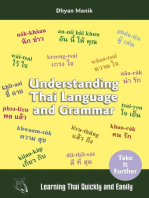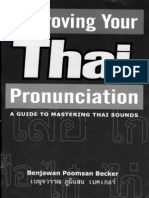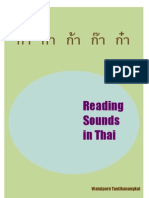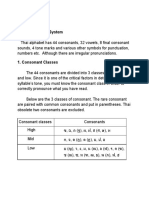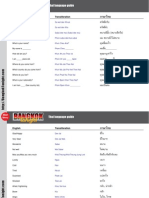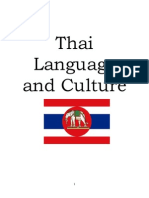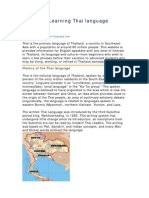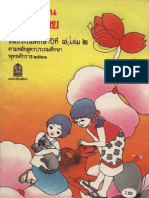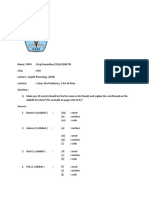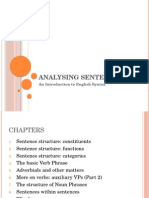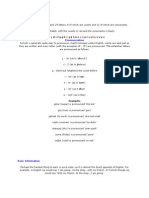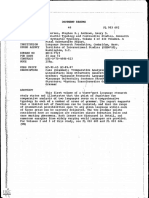Professional Documents
Culture Documents
THAI Grammar PDF
THAI Grammar PDF
Uploaded by
ShirlOriginal Title
Copyright
Available Formats
Share this document
Did you find this document useful?
Is this content inappropriate?
Report this DocumentCopyright:
Available Formats
THAI Grammar PDF
THAI Grammar PDF
Uploaded by
ShirlCopyright:
Available Formats
Thai Grammar Notes
INTRODUCTION 2
NOUNS 3
VERBS 3
ADJECTIVES 6
PERSONAL PRONOUNS 7
RELATIONSHIPS 8
PREPOSITIONS 8
QUESTIONS 9
CLASSIFIERS 11
NEGATIVE STATEMENTS 13
COMPARISONS 13
SUPERLATIVE COMPARISONS 14
REQUESTS 15
NUMBERS 16
WANT TO LEARN MORE? 17
These grammar notes are a summary from the grammar notes in our Language
Learning App L-Lingo Thai. L-Lingo is a comprehensive language learning app
with 105 lessons, a 5000 words vocab builder, native audio and fun quizzes.
More details: https://l-lingo.com/en/learn-thai/index.html
page 2
Introduction
When compared to other Languages, on a fundamental level the Thai grammar is
actually very simple. Each word normally stays the same; thus, there are no
declinations, no conjugations, no plural forms, no genders and no articles.
Whereas the English word to go might have different forms
like goes, went, going etc., the equivalent Thai word pai always stays the same,
regardless of the context.
However, there are also elements in the Thai language that we do not
have in many Western Languages.
No Blanks between Words
One thing that learners find quite difficult is that there are no
spaces between the words. As this is very tough, especially for Thai
learners, we have put spaces in between the words in these notes.
Tones
One of the most difficult element for the learner of the Thai language is
the correct pronunciation of the five phonemic
tones: middle, low, falling, high and rising because the concept of Tones
is not existing in many European Languages including English.
These grammar notes are from our 105 Lessons Language Learning App L-Lingo
www.l-lingo.com
© Smart Language Apps Ltd.
page 3
Word Order
In Thai, the word order is Subject-Verb-Object. This is the same as the
word order in English (e.g. Tom goes home).
Formal Tone - Krab and Ka
In spoken Thai language, at the end of most sentences, the
particle Krab (ครับ) for a man, and Ka (ค่ะ) for a woman are
added indicating respect. These words can also be used to indicate an
affirmative, but the ค่ะ (falling tone) is changed to a คะ (high tone).
Nouns
Nouns are pretty simple in the Thai language. They do not have articles
nor genders, and there is no distinction between singular or plural. As it
is easy to go without articles and genders, it is important to convey
singular or plural.
Verbs
Now that we already learned how to use nouns, in order to make
complete sentences, we need to know about verbs.
I have some good news here too. Verbs are also pretty straight forward
in Thai! They do not change with person, tense, number and there are
These grammar notes are from our 105 Lessons Language Learning App L-Lingo
www.l-lingo.com
© Smart Language Apps Ltd.
page 4
no particles. Additional information (e.g. tenses, plural etc.) is conveyed
by adding additional words (e.g. tense makers).
Present Tense
In this lesson, we will learn the present tense and we just need to use
the basic form. To emphasize the present tense, the word กําลัง (gam-
lang) is sometimes put in front of the verb.
Example:
ผู ้หญิง กําลัง ยืน อยู่
phû yĭng gam-lang yuen yù
The woman is standing.
Past tense
Past tense is indicated by แล ้ว (láeo - already) which is placed after the
verb.
Example:
ม ้าได ้ กระโดด ไป แล ้ว
má dâi krà-dòt pai láeo
The horse jumped.
There is also an alternative way to make past tense with ได ้ (dâi).
These grammar notes are from our 105 Lessons Language Learning App L-Lingo
www.l-lingo.com
© Smart Language Apps Ltd.
page 5
Have a look at this example:
ผู ้ชาย ได ้ ไป ปี น ภูเขา
phû chai dâi pai bin phu khăo
The man has climbed the mountain.
Since ได ้ (dâi) means can, it implies that something has been achieved
and thus happened in the past.
Future Tense
Future tense is indicated by จะ (chà - will) which is placed in front of the
verb.
Example:
ม ้า กําลัง จะ กระโดด
má gam-lang chà krà-dòt
The horse is going to jump.
There is one interesting case in future tense, that we did not yet look
into.
Have a look at this sentence:
ี ดง กําลัง จะ ชนะ
ทีม สแ
thim sĭ daeng kam-lang chà chá-ná
These grammar notes are from our 105 Lessons Language Learning App L-Lingo
www.l-lingo.com
© Smart Language Apps Ltd.
page 6
The red team is going to win.
Use of กําลัง (kam-lang)
Isn't it strange that we use กําลัง (kam-lang) in this sentence?
The reason is that in the above sentence, the race is already ongoing and
that the red team is already leading (present tense) and we make a
prediction on the outcome (future tense).
Adjectives
If you like to describe certain things, the adjective normally follows the
noun.
Look at this example:
ืE เชต
เสอ ิE สฟ
ี ้ า นัน
E ใหม่
sûea chóet sĭ fá nán mài
The blue shirt is new.
Here we have actually two adjectives following the
ืE เชต
noun shirt (เสอ ิE / sûea chóet):
These grammar notes are from our 105 Lessons Language Learning App L-Lingo
www.l-lingo.com
© Smart Language Apps Ltd.
page 7
ี ้ า / sĭ fá indicates the color blue (note that ส ี / sĭ - color acts as a
1) สฟ
classifier)
2) ใหม่ / mài indicates that the shirt is new
E / nán refers to the place of the shirt (like the English
Please note that นัน
word 'that').
Personal Pronouns
These are common personal pronouns in Thai:
ผม phom I/me - This is used by male speakers
ดิฉัน dì-chăn I/me - This is used by female speakers
เธอ thoe she/her (informal) (also you)
เขา khăo he/him, she/her
ของ เขา / khŏng khăo his
ของ เธอ / khŏng thoe her
ของ ผม / khŏng phŏm my – This is used by male speakers
ของ ฉั น / khŏng chăn my – This is used by female speakers
These grammar notes are from our 105 Lessons Language Learning App L-Lingo
www.l-lingo.com
© Smart Language Apps Ltd.
page 8
Relationships
You will also learn one speciality of the Thai
Language. Relationships are very important in Thailand and so are age
differences. This means that there are special words for older or
younger brothers and sisters.
Have a look at the following words which will be used in this lesson:
น ้องชาย (nóng chai) – younger brother
น ้องสาว (nóng săo) – younger sister
พีช
L าย (phî chai) – older brother
พีส
L าว (phî săo) – older sister
As you can probably guess,
พีL (phî) indicates 'older' and น ้อง (nóng) indicates 'younger'.
Prepositions
Some important prepositions are:
on (บน / bon)
in (ใน / nei)
under (ใต ้ / tâi).
These grammar notes are from our 105 Lessons Language Learning App L-Lingo
www.l-lingo.com
© Smart Language Apps Ltd.
page 9
One important concept in Thai Grammar is the use of the
word อยู่ (yù) to indicate 'place'. So อยู่ (yù) is positioned in front of
prepositions if they indicate a place.
Look at this example:
เด็กทารก อยู่ ใน รถยนต์
dèk tha rók yù nai rót-yon
A baby in a car.
In the above sentence you notice that อยู่ (yù) is placed in front of the
preposition ใน (nai) in order to define where the baby is.
Questions
There are a few different ways to make questions in the Thai language,
let us discuss each of them below.
A) Using the general question words ไหม (măi) or หรือ (rŭe)
These words are question words which are just added at the end of the
sentence. Look at for instance:
คุณ สบาย ดี หรือ ครับ
khun sà-bai di rŭe khráp
These grammar notes are from our 105 Lessons Language Learning App L-Lingo
www.l-lingo.com
© Smart Language Apps Ltd.
page 10
How are you?
Take note that the word ไหม (măi) or หรือ (rŭe) is placed before
the polite particle Krab (ครับ) for a man, and Ka (ค่ะ) for a woman.
B) You can also make questions by using specific question
words like what (อะไร / à-rai), where (ทีไL หน / thî năi), who (ใคร / krai) or
why (ทําไม/ tam-mai).
These question words are positioned after the verb in order to ask for a
specific thing.
However, the question word อะไร (à-rai) can also be placed at the
beginning of the question.
Have a look at this example:
อะไร อยู่ บน รูปภาพ
à-rai yù bon rûp phâp
What's in the picture?
The question word WHAT
ผู ้หญิง กําลัง ทํา อะไร อยู่
phû yĭng gam-lang tam à-rai yù
These grammar notes are from our 105 Lessons Language Learning App L-Lingo
www.l-lingo.com
© Smart Language Apps Ltd.
page 11
What is the woman doing?
Please note that in this example กําลัง (gam-lang) indicates present tense
and that the word อยู่ (yù) is also used since the question asks for a
specific location.
The question word WHERE
Since being able to ask questions is really important, we will continue with
questions and focus on the question word where (ทีไL หน / thî năi) in this lesson.
Have a look at the following example:
เด็กผู ้ชาย อยู่ ทีไL หน
dèk phû chai yù thî năi
Where is the boy?
Just remember that the word อยู่ (yù) is also used since the question asks for a
specific location.
Classifiers
Have a look at the following example:
E ส ี อะไร
รถยนต์ คัน นัน
These grammar notes are from our 105 Lessons Language Learning App L-Lingo
www.l-lingo.com
© Smart Language Apps Ltd.
page 12
rót-yon khan nán sĭ à-rai
What color is the car?
You probably wonder what (คัน นัน
E / khan nán) means.
คัน (khan) is a classifier noun. This is something particular in Thai (which does not
exist in English). Remember when I mentioned that some words in Thai do not
have equivalents in English? Yes, this one is an example.
Classifier nouns are used in questions, and are placed after numbers, or if you
E / nán).
refer to something specific like in this sentence (นัน
The classifier for car is คัน (khan) and that is why it is used in the above example.
Unfortunately, there are many different classifiers.
Common Classifiers:
The following list shows you the most common ones:
an อัน for small objects, things (in general)
chà-bàp ฉบับ for letters, newspapers
baan บาน for windows, doors, picture frames, mirrors
bai ใบ for round hollow objects , leaves
khan คัน for vehicles, umbrellas,cars
khon คน for a person, a child, human beings
These grammar notes are from our 105 Lessons Language Learning App L-Lingo
www.l-lingo.com
© Smart Language Apps Ltd.
page 13
khuû คู่ for pairs of articles, forks and spoons
lam ลํา for boats, ships, aeroplanes
lêm เล่ม for books, candles, scissors
phŏn ผล for fruits
lûk ลูก for balls
tua ตัว for animals, insects, fish, tables and chairs, shirts, pants, coats, other living
creatures
Negative Statements
To give a sentence a negative meaning, just put the word นีใE ม่ (mâi)
or ใม่ไช ่ (mâi-châi) in front of verbs / adjective.
Example:
ั ท์ นีใE ม่ไช ่ สแ
โทรศพ ี ดง มันเป็ น สด
ี ํา
tho-rá-sàp ní mâi-châi sĭ daeng man pen sĭ dam
This telephone is not red, it's black.
Comparisons
How to make comparisons in the Thai language?
When we compare two things in Thai, normally it will come with the form "A +
These grammar notes are from our 105 Lessons Language Learning App L-Lingo
www.l-lingo.com
© Smart Language Apps Ltd.
page 14
adjective + กว่า / kwà B". This means A is more than B.
Please take note of this:
กว่า / kwa always follows the adjectives that it describes.
Have a look at this examples:
ผู ้หญิง สวย กว่า ผู ้ชาย
phû yĭng sŭay kwà phû chai
The woman is more beautiful than the man.
Superlative Comparisons
You have just learned about using กว่า / kwà for comparisons.
กว่า / kwà - more/better etc.
Now will learn how to do superlative comparisons (most).
Just have a look at this example:
้ เป็ น สต
ชาง ั ว์ ทีL ใหญ่ ทีL สุด ใน ภาพ
cháng pen sàt thî yài thî sùt nai phâp
The elephant is the biggest animal in the picture.
These grammar notes are from our 105 Lessons Language Learning App L-Lingo
www.l-lingo.com
© Smart Language Apps Ltd.
page 15
You can see that for 'biggest' in Thai, we use ใหญ่ ทีL สุด / yài thî
sùt whereas ใหญ่ / yài is the adjective (big) and ทีL สุด / thî sùt the suffix to make
it bigGEST.
Requests
How do you ask for something or make a request? This is very common, such as
in restaurants wherein we ask for a plate or a drink.
Look at this example:
กรุณา สง่ ชอนให
้ ้ ดิฉัน หน่อย
kà-rú-na sòng chón hâi dì-chăn nòi
Please pass me the spoon!
To make a polite request, there are two words used in the above example:
กรุณา (kà-rú-na) which starts the sentence and corresponds to the English
'please'. Then you can also add หน่อย (nòi) at the end of the sentence. Directly
translated หน่อย (nòi) means 'a little' and the purpose in questions is to make the
question sound more polite and cute.
These grammar notes are from our 105 Lessons Language Learning App L-Lingo
www.l-lingo.com
© Smart Language Apps Ltd.
page 16
Numbers
Counting in Thai is very simple. After ten, the counting is repeatedly the same.
However what makes counting more tricky is that you use the classifier
system explained previously.
Have a look at this example:
เด็กผู ้ชาย มี ลูกบอล หนึงL ลูก
dèk phû chai mi lûk-bon nùeng lûk
The boy has one ball.
You can see that the number 1 (หนึงL / nùeng) is then followed by
the classifier for ball which is lûk.
In the following table you will see that the building of numbers follows a very
regular pattern (you will continuously learn more numbers in some of the
following lessons):
0 - sŭun - ศูนย์
1 - nùeng - หนึงL
2 - sŏng - สอง
3 - săm - สาม
4 - sì - ส ีL
5 - hâ - ห ้า
6 - hòk - หก
These grammar notes are from our 105 Lessons Language Learning App L-Lingo
www.l-lingo.com
© Smart Language Apps Ltd.
page 17
7 - chèt - เจ็ด
8 - pàet - แปด
9 - kâo - เก ้า
ิ
10 - sìp - สบ
ิ เอ็ด
11 - sìp-èt - สบ
ิ สอง
12 - sìp-sŏng - สบ
ิ สาม
13 - sìp-săm - สบ
ิ ส ีL
14 - sìp-sì - สบ
ิ ห ้า
15 - sìp-hâ - สบ
ิ หก
16 - sìp-hòk - สบ
ิ เจ็ด
17 - sìp-chèt - สบ
ิ แปด
18 - sìp-pàet - สบ
ิ เก ้า
19 - sìp-kâo - สบ
20 - yîi-sìp - ยีส ิ
L บ
21 - yîi-sìp-èt - ยีส ิ เอ็ด
L บ
22 - yîi-sìp-sŏng - ยีส ิ สอง
L บ
ิ เอ็ด
31 - săm -sìp-èt - สามสบ
ีL บ
41 - sì-sìp-èt - สส ิ เอ็ด
Want to learn more?
I hope you enjoyed these grammar notes. If you would like to learn more Thai,
we invite you to have a look at our Thai online language learning app.
https://l-lingo.com/en/learn-thai/index.html
These grammar notes are from our 105 Lessons Language Learning App L-Lingo
www.l-lingo.com
© Smart Language Apps Ltd.
You might also like
- Read Thai in 10 Days - Bingo LingoDocument247 pagesRead Thai in 10 Days - Bingo LingoOrathai Nganphairojsakun87% (15)
- Reading and Writing THAI (Jintana Rattanakhemakorn) (Z-Library)Document152 pagesReading and Writing THAI (Jintana Rattanakhemakorn) (Z-Library)Klismann Viana100% (1)
- Thai Stories for Language Learners: Traditional Folktales in English and Thai (Free Online Audio)From EverandThai Stories for Language Learners: Traditional Folktales in English and Thai (Free Online Audio)No ratings yet
- Easy Thai: Learn to Speak Thai Quickly (Includes Downloadable Audio)From EverandEasy Thai: Learn to Speak Thai Quickly (Includes Downloadable Audio)Rating: 4.5 out of 5 stars4.5/5 (4)
- Thai 1 Exercise Book (July 2022)Document153 pagesThai 1 Exercise Book (July 2022)東印一周宸安100% (1)
- Thai Language 1000 WordsDocument38 pagesThai Language 1000 Wordslearningcurveasia3076100% (5)
- Reading & Writing Thai: A Workbook for Self-Study: A Beginner's Guide to the Thai Alphabet and Pronunciation (Free Online Audio and Printable Flash Cards)From EverandReading & Writing Thai: A Workbook for Self-Study: A Beginner's Guide to the Thai Alphabet and Pronunciation (Free Online Audio and Printable Flash Cards)Rating: 3 out of 5 stars3/5 (1)
- Thai Picture Dictionary: Learn 1,500 Thai Words and Phrases - The Perfect Visual Resource for Language Learners of All Ages (Includes Online Audio)From EverandThai Picture Dictionary: Learn 1,500 Thai Words and Phrases - The Perfect Visual Resource for Language Learners of All Ages (Includes Online Audio)No ratings yet
- Learning Thai With Kat Talks ThaiDocument38 pagesLearning Thai With Kat Talks ThaiChalmers Campbell100% (2)
- Thai Particles (For PDFDocument45 pagesThai Particles (For PDFBayu100% (5)
- Understanding Thai Language and Grammar: Learning Thai Quickly and EasilyFrom EverandUnderstanding Thai Language and Grammar: Learning Thai Quickly and EasilyNo ratings yet
- Learn Thai: Start Speaking Today. Absolute Beginner to Conversational Speaker Made Simple and Easy!From EverandLearn Thai: Start Speaking Today. Absolute Beginner to Conversational Speaker Made Simple and Easy!Rating: 4.5 out of 5 stars4.5/5 (2)
- Writing Thai Letters: Thai Alphabet Workbook FREE SAMPLEDocument20 pagesWriting Thai Letters: Thai Alphabet Workbook FREE SAMPLEKruMark100% (4)
- Thai - 1000 Most - Common Thai WordsDocument42 pagesThai - 1000 Most - Common Thai WordsNo NameNo ratings yet
- Intensive Thai - Student TextbookDocument104 pagesIntensive Thai - Student Textbookkawaii shoujo100% (1)
- Intensive Thai - Solution BookDocument18 pagesIntensive Thai - Solution Bookkawaii shoujo100% (1)
- Read and Write Thai PDF FreeDocument133 pagesRead and Write Thai PDF FreeOrathai NganphairojsakunNo ratings yet
- 01 Improving Your Thai Pronunciation A Guide To Mastering Thai SoundsDocument45 pages01 Improving Your Thai Pronunciation A Guide To Mastering Thai SoundsYahoo_serious100% (9)
- Reading Sounds in Thai: Walaiporn TantikanangkulDocument42 pagesReading Sounds in Thai: Walaiporn TantikanangkulDavid Williams100% (3)
- Thai For BeginnersDocument256 pagesThai For Beginnersmalvinonline89% (19)
- Learning Thai with Original Thai Words: Learning Thai Quickly and EasilyFrom EverandLearning Thai with Original Thai Words: Learning Thai Quickly and EasilyNo ratings yet
- Learn Basic - Thai - LanguageDocument25 pagesLearn Basic - Thai - LanguagePianoteCuba100% (2)
- Parallelism MarkersDocument5 pagesParallelism Markersasthana.a961No ratings yet
- German Reflexive Verbs and PrepositionsDocument3 pagesGerman Reflexive Verbs and Prepositions711debbie25% (4)
- Teaching English Spelling - A Practical GuideDocument53 pagesTeaching English Spelling - A Practical GuideKavita Krishnamorthi100% (2)
- Tuttle Pocket Thai Dictionary: Thai-English / English-ThaiFrom EverandTuttle Pocket Thai Dictionary: Thai-English / English-ThaiNo ratings yet
- Thai Alphabet PDFDocument5 pagesThai Alphabet PDFAdyan Kurosacky67% (3)
- Ntroduction: The Thai Writing SystemDocument18 pagesNtroduction: The Thai Writing SystemlunanxlNo ratings yet
- Thai Book 1Document126 pagesThai Book 1Maung Si100% (8)
- Learn ThaiDocument18 pagesLearn ThaiJENDRY AYU SILAMBINo ratings yet
- Practice Worksheet: Thai Characters 1. 2 3. 4. Character Practice Thai Words QuizDocument16 pagesPractice Worksheet: Thai Characters 1. 2 3. 4. Character Practice Thai Words QuizIan Delaney100% (1)
- Thai Reader Project Volume 1Document278 pagesThai Reader Project Volume 1Tran Nguyen75% (4)
- Pub - A Simple Thai Grammar 1 PDFDocument75 pagesPub - A Simple Thai Grammar 1 PDFMelody NguyenNo ratings yet
- Learn How To Speak ThaiDocument7 pagesLearn How To Speak ThaiMuhammad Irfan FaisalNo ratings yet
- Thai 1 ExersiceDocument152 pagesThai 1 Exersicezhimin wangNo ratings yet
- Learn Thai in OttawaDocument1 pageLearn Thai in OttawalearnThaiNo ratings yet
- THAI M1L1 Stu ForpdfDocument79 pagesTHAI M1L1 Stu ForpdfElaineAmaralNo ratings yet
- Thai For BeginnersDocument278 pagesThai For Beginnerspotioncomic100% (28)
- (Ebook) Bangkok - Thai Language GuideDocument15 pages(Ebook) Bangkok - Thai Language Guidealkemy2000100% (2)
- Thai Language Manual and CultureDocument21 pagesThai Language Manual and CultureHugh Fox III80% (5)
- Thai Reference GrammarDocument259 pagesThai Reference GrammarSasi75% (8)
- Thai TutorialsDocument5 pagesThai TutorialsAnton CruzNo ratings yet
- 10 Rules To Read Thai by BananaThaiDocument18 pages10 Rules To Read Thai by BananaThaiEce KILIÇNo ratings yet
- Thai PhrasesDocument29 pagesThai PhrasesTheWarningBell100% (5)
- "Houston" "Texas": Speaking Everyday Thai 1 Sample Lesson Everyday Thai Language SchoolDocument9 pages"Houston" "Texas": Speaking Everyday Thai 1 Sample Lesson Everyday Thai Language Schoollaura fialhoNo ratings yet
- Ultimate Grammar Cheat SheetDocument6 pagesUltimate Grammar Cheat SheetChalmers CampbellNo ratings yet
- Thai Language Lessons BeginnersDocument25 pagesThai Language Lessons Beginners윤은소No ratings yet
- My First Thai Body Parts Picture Book with English Translations: Teach & Learn Basic Thai words for Children, #7From EverandMy First Thai Body Parts Picture Book with English Translations: Teach & Learn Basic Thai words for Children, #7No ratings yet
- My First Thai People, Relationships & Adjectives Picture Book with English Translations: Teach & Learn Basic Thai words for Children, #13From EverandMy First Thai People, Relationships & Adjectives Picture Book with English Translations: Teach & Learn Basic Thai words for Children, #13No ratings yet
- Essential Thai: Speak Thai With Confidence! (Thai Phrasebook & Dictionary)From EverandEssential Thai: Speak Thai With Confidence! (Thai Phrasebook & Dictionary)No ratings yet
- Thailanguagebook 1 090905082237 Phpapp01Document52 pagesThailanguagebook 1 090905082237 Phpapp01Legner Ranises100% (1)
- ThaiDocument20 pagesThaireadbooksreadNo ratings yet
- Alfabeto ThaiDocument6 pagesAlfabeto Thaibalpomoreli100% (1)
- Thai Lesson 1Document89 pagesThai Lesson 1Jonathan LawNo ratings yet
- Straight To The Point - Emil VohlertDocument34 pagesStraight To The Point - Emil VohlertAndi Mustofa100% (2)
- Collins Thai 3000 Words and PhrasesDocument146 pagesCollins Thai 3000 Words and PhrasesGenti johnNo ratings yet
- FSI Thai Basic Course Volume 2, Student TextDocument420 pagesFSI Thai Basic Course Volume 2, Student TextRbell AbroadNo ratings yet
- Thai Alphabet and PronunciationDocument7 pagesThai Alphabet and PronunciationElmer CarterNo ratings yet
- Thai Basic Grammar ReferenceDocument18 pagesThai Basic Grammar ReferenceM Hafizh Abrar NursalNo ratings yet
- Learning ThaiDocument5 pagesLearning ThaiSheron CassimNo ratings yet
- Thai Book For Grade 1 (2nd Semester) Primary School StudentsDocument100 pagesThai Book For Grade 1 (2nd Semester) Primary School StudentsPokin Sakarinkhul100% (2)
- 31 Advanced Thai Reading and Vocabulary Building Volume 2Document138 pages31 Advanced Thai Reading and Vocabulary Building Volume 2Sergey StasishinNo ratings yet
- Grammar Summary 3 2Document4 pagesGrammar Summary 3 2api-326210415No ratings yet
- Primerofgothicl00wrig BW PDFDocument320 pagesPrimerofgothicl00wrig BW PDFcorvinNo ratings yet
- Diagramming Sentences Hand-Out 1Document10 pagesDiagramming Sentences Hand-Out 1TheodoreSmith100% (1)
- Tugas PhonologyDocument4 pagesTugas PhonologyRizqi RamseyNo ratings yet
- Welshgrammar Allrules PDFDocument87 pagesWelshgrammar Allrules PDFLajos Attila DarócziNo ratings yet
- EXAMEN de Ingles Bachillerato 3 y 5Document2 pagesEXAMEN de Ingles Bachillerato 3 y 5JEmilioGarciaP100% (1)
- Unit 7. Nature'S Warning The Passive VoiceDocument7 pagesUnit 7. Nature'S Warning The Passive VoiceRadu IonelNo ratings yet
- 08 Central Vowels DiphthongsDocument22 pages08 Central Vowels DiphthongsDavid Fernandez GamezNo ratings yet
- English Syntax The Simple Sentence: Ioana Murar Ana-Maria Trantescu Claudia PisoschiDocument76 pagesEnglish Syntax The Simple Sentence: Ioana Murar Ana-Maria Trantescu Claudia PisoschiMelania Anghelus100% (1)
- Synchronic and Diachronic ExplanationDocument4 pagesSynchronic and Diachronic ExplanationLeonardo AlvesNo ratings yet
- Many People Believe That Television Programs Are of No Value For Children-AnsweredDocument1 pageMany People Believe That Television Programs Are of No Value For Children-Answered1sailendra23No ratings yet
- Preposition Question Tag Correct Tense and Sentence PatternDocument7 pagesPreposition Question Tag Correct Tense and Sentence PatternVigneshVickeyNo ratings yet
- Introduction To English SyntaxDocument111 pagesIntroduction To English Syntaxaiulflihd100% (1)
- Sequence of Urdu LettersDocument6 pagesSequence of Urdu LettersPankaj ChauhanNo ratings yet
- UJAux Verbs R3Document186 pagesUJAux Verbs R3Hatice Yıldırım50% (2)
- TurkishDocument42 pagesTurkishmiaterry89100% (2)
- Polish Cases and Its ConjugationsDocument2 pagesPolish Cases and Its ConjugationsUmurhan BayriNo ratings yet
- Syntactic Typology and Contrastive Studi PDFDocument259 pagesSyntactic Typology and Contrastive Studi PDFappled.apNo ratings yet
- GrammarDocument75 pagesGrammaranon_272064427100% (1)
- 152-Haram Rishte&samaji Kharabiyan PDFDocument3 pages152-Haram Rishte&samaji Kharabiyan PDFmdtanzimalamNo ratings yet
- Difference Between Morpholgy and SyntaxDocument3 pagesDifference Between Morpholgy and SyntaxChairNo ratings yet
- Introduction To LinguisticsDocument211 pagesIntroduction To Linguisticsunifaun28No ratings yet
- Possessive Adjectives: Aggettivi PossessiviDocument2 pagesPossessive Adjectives: Aggettivi PossessiviDaniel GarcíaNo ratings yet
- Bahasa Inggris 1 Pertemuan 2 PDFDocument20 pagesBahasa Inggris 1 Pertemuan 2 PDFapi-204541474No ratings yet
- 52 Grammar Topics in English PDFDocument1 page52 Grammar Topics in English PDFMariam Bajelidze100% (1)
- Day 6 - Infinitive Phrases Mini LessonDocument2 pagesDay 6 - Infinitive Phrases Mini Lessonapi-283124333No ratings yet
- 1 Introduction Noun ClassesDocument2 pages1 Introduction Noun Classesdreaming222No ratings yet










